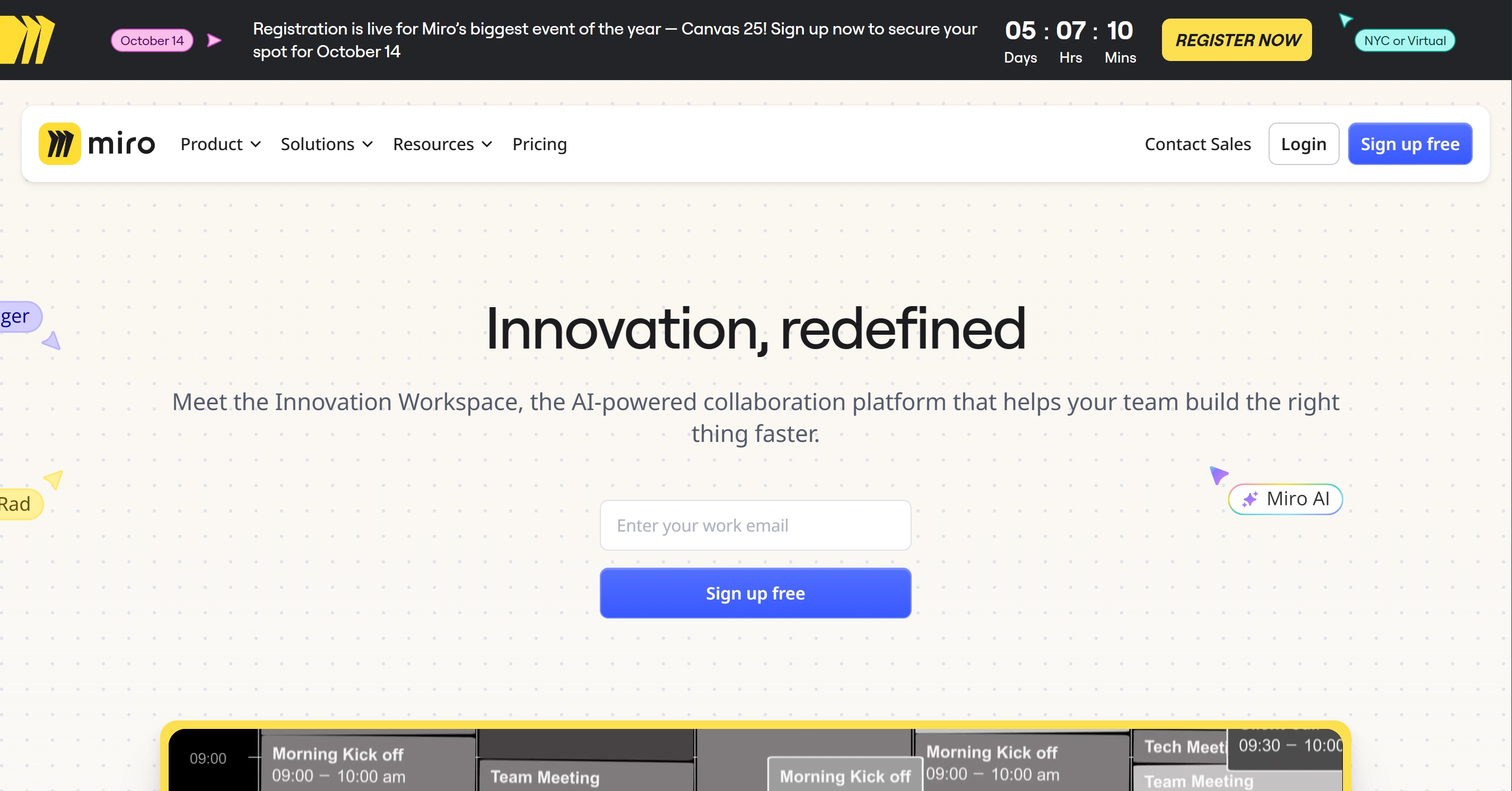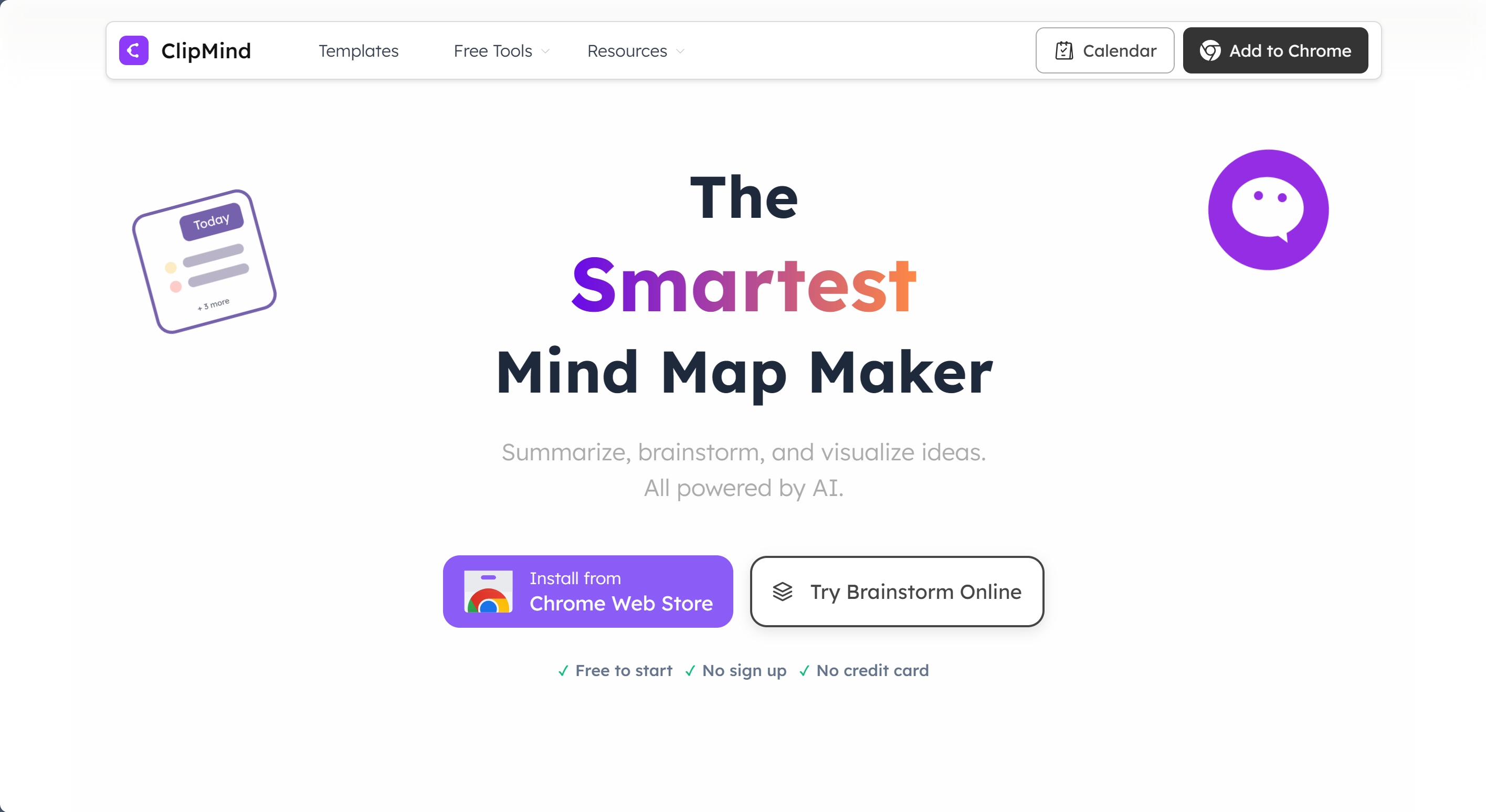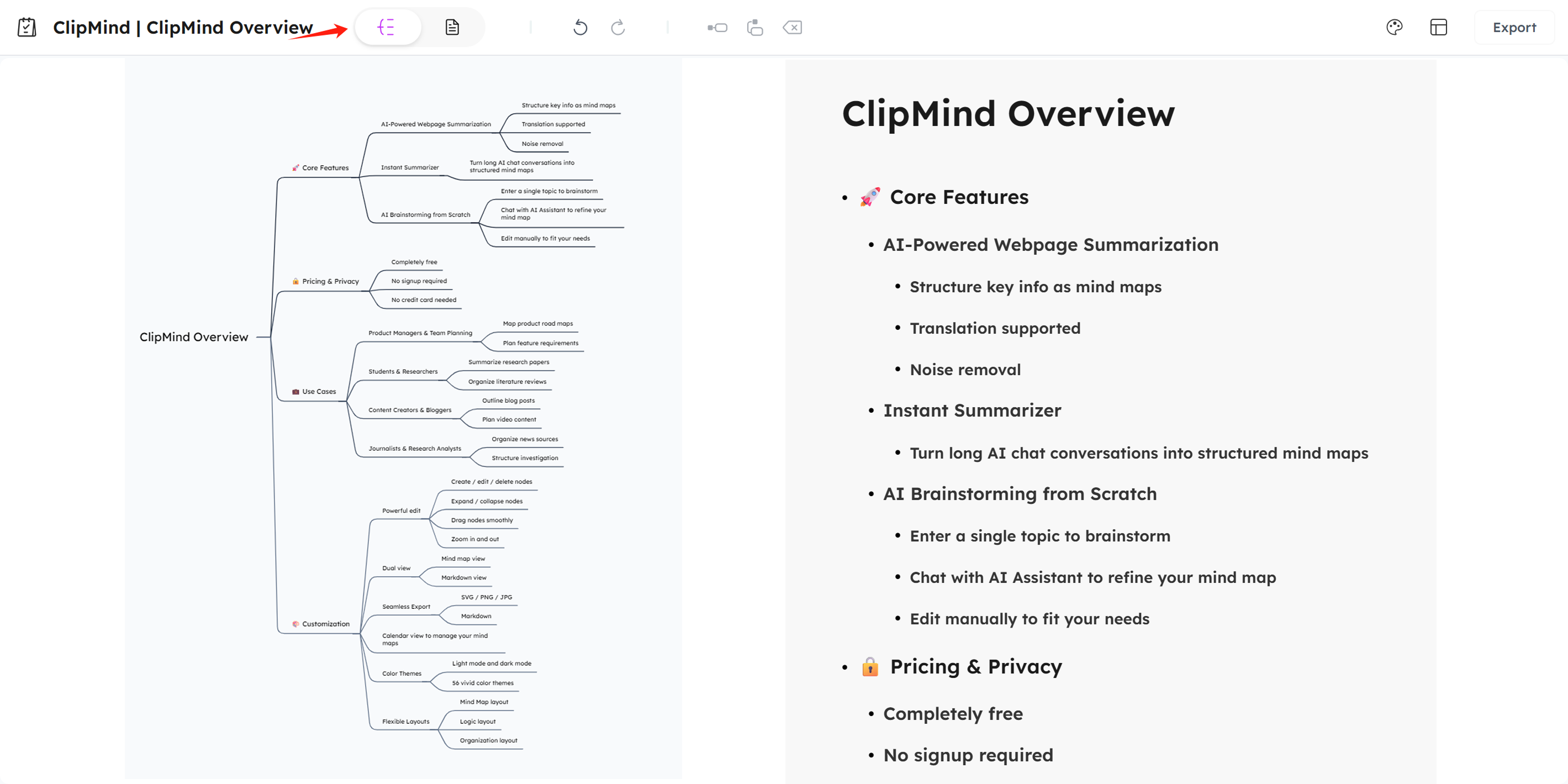TL; DR
- Miro excels for team collaboration and project visualization, while ClipMind specializes in AI-powered information structuring for individual knowledge work
- ClipMind's completely free model with no login requirements makes it accessible for students and individual professionals, unlike Miro's escalating pricing tiers
- ClipMind transforms unstructured web content into editable mind maps in one click, bridging the gap between reading comprehension and structured thinking
- Miro's template library and integration ecosystem support complex team workflows, but can be overwhelming for individual thinking tasks
- The ideal choice depends on whether your primary need is collaborative visualization (Miro) or AI-enhanced cognitive structuring (ClipMind)
Introduction
As someone who's tested dozens of productivity tools over the years, I've noticed an interesting trend: people are increasingly comparing collaborative whiteboarding platforms like Miro with specialized mind mapping tools. At first glance, this seems like comparing apples to oranges—until you realize both tools aim to help people organize thoughts and work more effectively.
The confusion makes sense when you consider that Miro's mind map examples organize complex ideas visually for brainstorming, planning, and collaboration across teams. But as I discovered through extensive testing, these tools serve fundamentally different purposes and excel in distinct scenarios.
This comprehensive comparison will help you understand whether Miro's collaborative whiteboard approach or ClipMind's AI-powered mind mapping better aligns with your specific workflow needs, thinking style, and collaboration requirements.
Understanding the Core Difference
The fundamental distinction between these tools lies in their primary design philosophy. Miro is built for team collaboration and spatial organization, while ClipMind is designed for individual cognitive structuring and AI-enhanced thinking.
Miro functions as a digital whiteboard where teams can visualize projects, processes, and ideas in a free-form canvas. It's excellent for workshops, brainstorming sessions, and project planning where multiple stakeholders need to contribute simultaneously. The platform helps teams move from ideation to execution seamlessly by embedding various thinking frameworks into existing workflows.
ClipMind, in contrast, focuses on transforming how individuals process and structure information. Its AI-powered approach automatically converts web content into editable mind maps, bridges visual thinking with structured writing through dual views, and provides cognitive support for idea development. Rather than being just another visualization tool, ClipMind acts as an AI layer for structured thinking.
This core difference explains why users might compare them despite their different purposes: both help organize thoughts, but they approach the challenge from opposite directions—one emphasizing collaborative space, the other focusing on individual cognition.
Decision Criteria: Who Each Tool Serves Best
Choosing between Miro and ClipMind depends on several key factors that align with different user profiles and workflow requirements. Based on my testing and research, here are the primary decision criteria:
Team Collaboration Needs
- High collaboration: Choose Miro if you regularly work with teams needing real-time co-creation
- Individual focus: Choose ClipMind if you primarily work alone or need deep thinking space
Information Processing Style
- Free-form exploration: Miro supports spatial organization and non-linear thinking
- Structured hierarchy: ClipMind enforces semantic relationships and logical connections
Budget Constraints
- Enterprise budget: Miro scales with organizational needs but costs increase significantly
- Individual affordability: ClipMind remains completely free with no feature limitations
Workflow Integration
- Existing tool ecosystems: Miro integrates with popular project management platforms
- Browser-based efficiency: ClipMind works seamlessly within your reading and research workflow
According to persona mapping research, different user segments have distinct needs that determine tool suitability. The collaborative team player thrives in Miro's environment, while the deep thinking individual finds more value in ClipMind's structured approach.
At-a-Glance Comparison Table
| Feature | Miro | ClipMind |
|---|---|---|
| Primary Focus | Team collaboration & project visualization | AI-powered individual thinking |
| Core Strength | Real-time collaboration, template library | AI summarization, cognitive structuring |
| Pricing Model | Freemium (Free, Starter $8/user, Business, Enterprise) | Completely free |
| Learning Curve | Moderate to steep | Minimal |
| AI Capabilities | Limited AI features in higher tiers | Comprehensive AI: comprehension, cognitive, creative |
| Collaboration | Excellent real-time team collaboration | Individual-focused with shareable outputs |
| Information Processing | Free-form spatial organization | Semantic hierarchy enforcement |
| Output Formats | PDF, PNG, CSV, embed codes | PNG, SVG, JPG, Markdown |
| Ideal For | Team workshops, project planning, agile workflows | Research summarization, content creation, studying |
| Login Required | Yes | No |
| Data Privacy | Cloud-based with enterprise security | Local processing, no data collection |
This comparison reveals that these tools aren't direct competitors but complementary solutions for different scenarios. Miro excels where collaboration scale matters, while ClipMind dominates in individual cognitive efficiency.
Deep Dive: Miro's Collaborative Whiteboard Platform
Miro has established itself as the go-to platform for team collaboration and visual project management. During my testing, I was impressed by how comprehensively it supports distributed team workflows.

Strengths That Stand Out
Miro's template library is exceptionally robust, offering pre-built frameworks for everything from agile sprints and customer journey maps to strategic planning sessions. The platform truly shines when you have multiple team members working simultaneously on complex projects. The real-time cursor tracking, comment system, and presentation mode make it feel like everyone is in the same room.
The integration ecosystem is another major advantage. Miro connects seamlessly with popular tools like Jira, Slack, Notion, and Google Drive, making it a central hub for visual collaboration. This is particularly valuable for organizations that have already invested in specific tool stacks and need their whiteboarding solution to play nicely with existing workflows.
Limitations for Individual Use
However, I found Miro less optimal for individual knowledge work. The platform's strength in collaboration comes with complexity that can feel overwhelming when you're working alone. As one Reddit user noted, Miro becomes expensive and hard to justify for ad hoc use cases, especially as user base grows.
The free version's limitations are particularly constraining for individual users. With only three editable boards and restrictions on advanced features, the free plan can become cluttered and make collaborative sessions less fluid. For teams that outgrow the free tier, costs escalate quickly, with Business plans running $16 per user monthly.
Deep Dive: ClipMind's AI-Powered Mind Mapping
ClipMind represents a fundamentally different approach to thinking tools—one that leverages AI to enhance individual cognition rather than facilitate team collaboration. After extensive testing, I found its AI capabilities genuinely transformative for knowledge work.

Three Pillars of AI Intelligence
What sets ClipMind apart is its integration of three distinct AI capabilities that work together seamlessly:
Comprehension AI automatically analyzes web content and extracts key information into structured mind maps. I tested this with several long research articles and was impressed by how accurately it identified main arguments, supporting evidence, and hierarchical relationships.
Cognitive AI helps users structure, relate, and connect ideas within their mind maps. This isn't just automated mind mapping—it's intelligent assistance that understands context and relationships between concepts.
Creative AI supports refining and expressing insights clearly, whether through expanding ideas, suggesting connections, or helping translate thoughts between visual and textual formats.
Unique Workflow Advantages
ClipMind's dual-view system bridges the gap between visual thinking and structured writing in a way I haven't seen in other tools. The ability to switch instantly between mind map view and Markdown view means you can brainstorm visually then export directly to your writing workflow without manual transcription.
The completely free pricing model with no login requirements makes ClipMind exceptionally accessible. Unlike tools that lock essential features behind paywalls, ClipMind offers full functionality including AI summarization, custom layouts, and flexible export options without cost barriers.

Workflow Comparison: From Information to Insight
Understanding how each tool handles the journey from raw information to structured insight reveals their fundamental differences in approach and efficiency.
Research and Information Gathering
When facing a complex research topic, Miro requires manual organization of information. You might create frames for different sources, use sticky notes for key points, and draw connections between concepts. This process is collaborative and visual but time-consuming for individual researchers.
ClipMind transforms this workflow through AI summarization. Instead of manually decomposing content, you can instantly convert web articles into editable mind maps. During my testing, what would typically take 30-60 minutes of manual organization became a 30-second process with ClipMind. The AI automatically filters out irrelevant content like ads and navigation, focusing only on substantive information.
Idea Organization and Development
Miro supports free-form idea organization through its infinite canvas approach. You can spatially arrange concepts, use different frameworks and templates, and collaborate with team members in real-time. This works well for workshops and group brainstorming sessions.
ClipMind takes a more structured approach to idea development. The enforced hierarchy ensures logical relationships between concepts, while the AI assistant acts as a thought partner for expanding and refining ideas. Research shows that mind mapping-based instruction has more positive influence on students' cognitive learning outcomes than traditional instruction, validating this structured approach.
Output Creation and Sharing
Miro excels at creating shareable visual artifacts that teams can continue collaborating on. The platform supports various export formats and embedding options, making it easy to integrate outputs into presentations, documentation, and project management tools.
ClipMind focuses on creating structured outputs that bridge visual thinking and written work. The ability to export as Markdown means your visual brainstorming can directly feed into documentation, reports, or content creation. This eliminates the friction between thinking and writing that often plagues knowledge workers.
Hands-On Scenarios and Results
To provide concrete comparisons, I tested both tools with common professional scenarios and documented the results.
Scenario 1: Research Paper Summarization
I selected a complex academic paper about AI ethics and used both tools to create a summary.
Miro Results: Creating a structured summary required approximately 45 minutes of manual work. I had to read the paper, identify key sections, create text boxes for main points, and draw connections between concepts. The output was visually appealing but time-intensive to create.
ClipMind Results: Using the AI summarization feature, I generated a comprehensive mind map in under 30 seconds. The tool automatically identified the paper's structure, main arguments, and supporting evidence. I spent another 15 minutes refining and customizing the map, resulting in a total time investment of under 20 minutes for a superior structured output.
Scenario 2: Project Planning Workshop
I simulated a project kickoff meeting requiring team input on scope, timeline, and responsibilities.
Miro Results: The platform excelled in this collaborative scenario. Using a project template, team members could simultaneously contribute ideas, vote on priorities, and assign tasks. The real-time collaboration features made the session productive and engaging.
ClipMind Results: While capable of creating project plans, ClipMind lacked the real-time collaboration features needed for effective workshop facilitation. However, the AI brainstorming capability helped generate comprehensive project components that could then be transferred to a collaboration tool.
Scenario 3: Content Strategy Development
I worked on developing a content strategy for a new product launch, requiring both creative brainstorming and structured planning.
Miro Results: The free-form canvas allowed creative exploration of content ideas, but required significant manual organization to create a actionable strategy. The spatial flexibility was both a strength and weakness—it enabled creativity but didn't enforce the structure needed for execution.
ClipMind Results: The AI-assisted brainstorming generated a comprehensive content framework with logical hierarchy. The ability to switch between visual mapping and Markdown outlining made it easy to transition from brainstorming to actionable content calendar creation.
Pricing and Accessibility Analysis
The pricing models and accessibility features reveal fundamentally different business philosophies and target audiences.
Miro's Escalating Cost Structure
Miro operates on a freemium model that becomes increasingly expensive as team needs grow:
- Free Plan: Limited to 3 editable boards with basic collaboration
- Starter Plan: $8 per user/month for unlimited boards and templates
- Business Plan: $16 per user/month for advanced features and security
- Enterprise Plan: Custom pricing for large organizations
For individual users or small teams, the free plan's three-board limit quickly becomes constraining. As noted in user discussions, the free version's limitations make collaborative sessions less fluid when working on multiple projects.
ClipMind's Completely Free Model
ClipMind stands out by offering all features completely free with no limitations:
- AI Summarization: Unlimited use
- Mind Mapping: Full editor with all layouts and themes
- Export Options: PNG, SVG, JPG, Markdown
- Collaboration: Shareable outputs without restrictions
- No Login Required: Immediate access without account creation
This approach aligns with research showing that free mind mapping tools with no login requirements are specifically valuable for individual users and students. The absence of pricing barriers makes advanced AI-powered thinking accessible to everyone.
Accessibility and Privacy Considerations
Miro requires account creation and stores data in the cloud, which provides convenience for teams but raises privacy considerations for sensitive information. ClipMind processes everything locally with no data collection, appealing to users with privacy concerns or proprietary information.
When to Choose Miro vs ClipMind
Based on my comprehensive testing and analysis, here's clear guidance for choosing between these tools:
Choose Miro When:
- You need real-time collaboration with teams of 3+ people
- Your workflow involves workshops, design sprints, or agile ceremonies
- You require integration with existing project management tools
- Budget allows for $8-16 per user monthly subscriptions
- Your primary need is visual project management rather than deep thinking
Choose ClipMind When:
- You work primarily as an individual or need deep thinking space
- Your workflow involves extensive research and information processing
- Budget is a concern or you prefer completely free tools
- Privacy matters and you prefer local processing
- You need to bridge visual thinking with structured writing
- AI assistance for comprehension and idea development would enhance your work
Hybrid Approach
Many users will benefit from using both tools for different purposes. For example, using ClipMind for individual research and idea development, then exporting structured outputs to Miro for team collaboration and refinement.
This hybrid approach leverages the strengths of each tool while mitigating their limitations. ClipMind handles the cognitive heavy lifting of information processing, while Miro facilitates the collaborative refinement and execution planning.
Conclusion and Recommendation
After extensive testing and analysis, it's clear that Miro and ClipMind aren't competitors but complementary tools serving different aspects of the modern knowledge workflow.
Miro excels as a collaborative visualization platform that brings teams together around shared understanding and project execution. Its strength lies in facilitating group thinking, workshops, and visual project management at scale.
ClipMind revolutionizes individual thinking through AI-powered cognitive support that transforms how we process information, develop ideas, and bridge thinking with writing. Its completely free model with no barriers to access makes advanced thinking tools available to everyone.
Final Recommendations:
For teams and organizations prioritizing collaboration and project visualization, Miro remains the industry standard worth the investment.
For individuals, students, and professionals focused on research, content creation, and deep thinking workflows, ClipMind offers unprecedented value and cognitive support at no cost.
For hybrid workers who need both individual thinking space and team collaboration capabilities, using both tools in complementary ways provides the most comprehensive solution.
The best tool isn't necessarily the most feature-rich or expensive—it's the one that aligns with your specific thinking style, workflow needs, and collaboration requirements. Both Miro and ClipMind represent significant advancements in their respective domains, and the choice between them ultimately depends on which type of thinking you need to support most.
Learn More
- ClipMind Free AI Tools
- How to Create Mind Maps from Webpages: Complete Guide
- Miro Templates and Examples
- Research on Mind Mapping Cognitive Benefits
- Whiteboard Apps vs Mind Mapping Tools
FAQs
-
Can ClipMind handle team collaboration like Miro? No, ClipMind is designed for individual thinking and knowledge work. While you can share exported mind maps, it doesn't offer real-time collaboration features. For team collaboration, Miro remains the superior choice.
-
Is Miro suitable for individual users on a budget? Miro's free plan is limited to 3 editable boards, which may be sufficient for occasional use but becomes restrictive for ongoing individual work. ClipMind offers unlimited use completely free, making it better for budget-conscious individuals.
-
How accurate is ClipMind's AI summarization feature? During testing, ClipMind's AI demonstrated strong accuracy in identifying main ideas, supporting points, and hierarchical relationships. However, like any AI tool, results should be reviewed and refined, especially for complex or technical content.
-
Can I use both tools together in my workflow? Absolutely. Many users benefit from using ClipMind for individual research and idea development, then exporting structured outputs to Miro for team collaboration and visual refinement.
-
Does ClipMind work with content behind paywalls or login walls? ClipMind can summarize any publicly accessible web content. For content behind paywalls or requiring login, you would need to use the manual mind mapping features or copy-paste content.
-
How does Miro's AI compare to ClipMind's AI capabilities? Miro offers limited AI features focused mainly on template suggestions and content organization. ClipMind provides comprehensive AI support including summarization, brainstorming, and cognitive assistance specifically designed for thinking workflows.
-
Are there any hidden costs with ClipMind's free model? No, ClipMind is completely free with no feature limitations, hidden costs, or planned introduction of paid tiers. The business model focuses on accessibility rather than monetization through user subscriptions.
